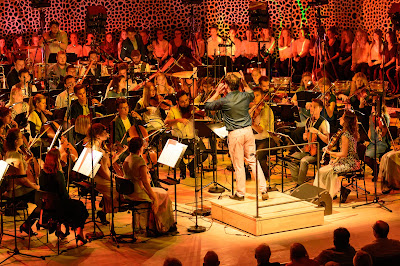 |
| Kristjan Järvi & Baltic Sea Philharmonic at the Elbphilharmonic (Photo (c) BMEF / Peter Adamik) |
Reviewed by Robert Hugill on Aug 29 2017
Star rating:
Kristjan Järvi and his young players fill the Elbphilharmonie with vibrant music-making
 |
| Mikhail Simonyan, Kristjan Järvi & Baltic Sea Philharmonic (Photo (c) BMEF / Peter Adamik) |
We entered the hall with the striking visuals playing on ceiling and walls, and sounds of water around us. The visual side, whilst very striking, was not perhaps sufficiently immersive and I understand at other venues on the tour the designers had been able to create a more total environment. But then, the Grosser Saal of the Elphilharmonie is a striking experience in its own right.
 |
| Baltic Sea Philharmonic at the Elbphilharmonic (Photo (c) BMEF / Peter Adamik) |
Philip Glass's Violin Concerto No. 2 'The American Four Seasons' was written in 2009 as a response to Vivaldi's The Four Seasons, but Glass's reaction to the Vivaldi is guarded and he does not reveal which movement is which. Add to this, that each of the four movements is preceded by a solo violin movement (prologue and three songs) and the result is striking in its own right. Written for strings and keyboard, this was the most intimate music of the evening. The Philip Glass on display was a long way form the Glass of Einstein on the Beach, and the music was notable for the way Glass kept control of the textures with great fluidity, rather than laying down a rhythmic pattern and letting it flow. There was little peaceful noodling here.
We started with a solo violin prologue, with Mikhail Simonyan (playing from memory) evoking the music as a response to Bach. Rather than the solo violin moments punctuating the orchestral music, it more felt as if Glass allowed each movement to run its course, gradually unwinding into the solo violin line. Within this fluid structure there was much to enjoy, perhaps most notably a wonderfully lyrical slow movement.
 |
| Kristjan Järvi & Baltic Sea Philharmonic at the Elbphilharmonic (Photo (c) BMEF / Peter Adamik) |
The music in the second half, Philip Glass's Aguas da Amazonia, was perhaps more crowd pleasing and certainly dazzlingly orchestrated by Charles Coleman to show off the different sections of the orchestra, but I do not thing the 55 minute work was quite as musically satisfying as the concerto. What made it was the energy and commitment of the players, conveying every inch of vitality in the music.
Structured as 10 movements each depicting a tributary of the river Amazon, the later movements all seemed to rely a little too heavily on the example of Villa Lobos's train music, though in Kristjan Järvi and the orchestra's hands the results were intoxicatingly exciting. At times this did not sound like Philip Glass and we were aware that a number of hands were responsible for the work both in assembling the original suite and then Charles Coleman's orchestration.
Coleman gave us some fine solo moments, Charlie Porter's trumpet had a rather Spanish solo, Mat Fieldes' electric bass had its moment in the spotlight, as did instruments as varied as the orchestral basses and the trombones. Much of the writing was challenging, and this was a real orchestral work-out, a concerto for orchestra which the players performed with style, vitality and highly communicative energy.
 |
| Kristjan Järvi & Baltic Sea Philharmonic at the Elbphilharmonic (Photo (c) BMEF / Peter Adamik) |
Things did not end there, and when we descended to the quayside after the concert, members of the orchestra were giving an impromptu outdoor concert.
Elsewhere on this blog:
- Ideas and creative energy: Frank Castorf's production of Wagner's Ring Cycle at Bayreuth - Opera review
- Mozart's La Clemenza di Tito at the BBC Proms - opera review
- Weekend reading The rise, fall and gradual resurgence of Meyerbeer's French operas, a story of stylistic change, anti-Semitism and personal spite - feature article
- Debut recital: Luc Robert in Verdi arias - CD review
- Riveting and exciting: Die Meistersinger from Bayreuth - Opera review
- Magnificent staging: Wagner's Parsifal at Bayreuth - Opera review
- Viola & accordion: Duo van Vliet's Lachrymae ReVisited - CD review
- Powerful, compelling, satisfying: Tristan und Isolde at the Bayreuth Festival - opera review
- An eventful morning in East London: 21st Century violin concertos - CD review
- Bach in context: St John Passion & Lutheran Vespers at the BBC Proms - concert review
- Large scale beauties: Schoenberg's Gurrelieder at the BBC Proms - concert review
- Singing Wagner: A continuation of our conversation between Claire Rutter and Dame Anne Evans - interview
- Home











Short addition: The choral piece/improvisation was performed by the hamburg girls choir - an quit excellent amateur choir from hamburg.
ReplyDelete